Services on Demand
Journal
Article
Indicators
-
 Cited by SciELO
Cited by SciELO -
 Access statistics
Access statistics
Related links
-
 Cited by Google
Cited by Google -
 Similars in
SciELO
Similars in
SciELO -
 Similars in Google
Similars in Google
Share
Agronomía Colombiana
Print version ISSN 0120-9965
Agron. colomb. vol.33 no.1 Bogotá Jan./Apr. 2015
https://doi.org/10.15446/agron.colomb.v33n1.47132
Doi: 10.15446/agron.colomb.v33n1.47132
1 La Selva Research Center, Corporacion Colombiana de Investigacion Agropecuaria (Corpoica). Rionegro (Colombia). cpassaro@gmail.com
Received for publication: 8 November, 2014. Accepted for publication: 30 March, 2015.
ABSTRACT
Product quality and safety are two essential characteristics for the fruit market, making it necessary to normalize and standardize processes in order to improve their commercialization. In this study, the quality of two Andean blackberry cultivars grown in two regions of Antioquia (Envigado and Guarne), Colombia, from different maturity stages as defined by the Norma Tecnica Colombiana 7146 (NTC Spanish) was characterized. The parameters that were found suitable for the fruit quality characterization were: weight, total solid soluble content (TSS), titratable acidity (TA), maturity index (MI), color index (CI) and firmness (F). The equatorial diameter (ED) maintained its importance relative to the standard and the market, along with the juice yield (JY). The quotient a*/b* presented the best correlation with the visual color scale as defined in the standard. The TSS ranges defined in NTC 4106 were not verified in this studied for fruits grown in the agro-climatic conditions of Antioquia. Linear regression models are a useful tool for making quick and easy comparisons and estimations of the quality parameters.
Key words: fruit, postharvest, physico-chemical parameters, quality controls, standardization.
RESUMEN
Actualmente la calidad e inocuidad de los productos es un requisito de los mercados de frutas, haciendo necesario la estandarización y normalización de los procesos. En este estudio, se caracterizó la calidad de dos cultivares de mora de 'Castilla' producidos en dos localidades de Antioquia (Envigado y Guarne), Colombia, en los diferentes estados de madurez que define la NTC 4106. Los resultados mostraron que los parámetros más adecuados para la caracterización de la calidad del fruto fueron: peso, solidos solubles totales (SST), acidez titulable (AT), índice de madurez (IM), índice de color (IC) y firmeza (F). Se encontró que el diámetro ecuatorial (DE) guarda su importancia respecto a la norma y el mercado, así como el rendimiento en zumo (RZ). El cociente a*/b* fue el que presentó mejor correlación con la escala visual de color definida en la norma. Los rangos de SST definidos en la norma no se verificaron en este estudio para las condiciones agroclimáticas de Antioquia. Los modelos de regresión linear son una herramienta útil para realizar comparaciones y estimaciones rápidas de los parámetros de calidad.
Palabras clave: frutas, poscosecha, parámetros fisicoquímicos, control de calidad, estandarización.
Introduction
The blackberry (Rubus sp.) has become a common fruit in fresh and processed fruit markets, particularly in North America and the European Union. A worldwide area of 25,000 ha is estimated and in the USA, this fruit's shipments have increased from 4,500 kg in 2000 to about 54,545 kg in 2010 (Clark and Finn, 2014).
In Colombia, the Andean blackberry (Rubus glaucus Benth.), also known as the 'Castilla' blackberry, is a traditional rural crop grown by small producers, having an area of 12,281 ha, a production of 105,218 t and a productivity of 8.6 t ha-1. Cundinamarca (3,275 ha, 24,239 t and 7.4 t ha-1), Santander (1,793 ha, 19,190 t and 10.7 t ha-1) and Antioquia (1,430 ha, 13,728 t, 9.6 t ha-1) are the departments best positioned in terms of area and production, but Risaralda (14.0 t ha-1) and Santander presented the best performance. In 2013, Colombia exported 19 t, representing US$51,000. The blackberry fruit is exported mainly when it is fresh, frozen or processed and the principal destinations in 2013 were the USA, Spain, Russia, UK, Australia and Panama. Nevertheless, imports are high, reaching 33,032 t and US$94,082,000 in 2013, especially from Chile (86%) and the USA (15%) (Escobar, 2014).
This fruit enjoys high consumption in Colombia (1.5 kg year-1 per capita 2013), with wide consumption acceptance as fresh produce (60%), and is highly regarded in the processed industry (40%) due to its exotic flavor and easy processing (Escobar, 2014). The consumption of blackberries in the world has increased in recent years due to the content of phenolic compounds and vitamin C, which can help in the prevention of degenerative diseases (Lewers et al., 2010; Ali et al., 2011). Additionally, natural pigments, especially anthocyanins, provide attractive colors for the food manufacturing industry, jellies and syrups (Acosta-Montoya et al., 2010).
In recent years, there has been greater concern over consumer availability of edible fruits that have reached a satisfactory level of maturity and that show their true organoleptic characteristics. Icontec, in its technical standard NTC 4106 (Icontec, 1997), established the requirements demanded of Andean blackberry fruits in Colombia for fresh markets or as a commodity for the processing industry, including specific requirements such as total soluble solids (TSS), titratable acidity (TA), maturity index (MI) and tolerances of quality, size and color. However, the latest update of this standard was in 1997, which requires review and adaptation to current needs.
According to Clark and Finn (2008), the USA industry prefers a blackberry flavor and high color, low pH, high content of soluble solids and acidity, low perception of seeds, and small drupes, while for consumers, qualities such as sweetness, acidity, astringency, color, firmness and absence of seeds are important for both processed and fresh fruits.
Guedes et al. (2013) assessed the quality and mineral content of different blackberry cultivar fruits produced in a tropical climate (Cwb, Köppen classification) in Brazil at 918 m a.s.l., finding that the chemical characteristics combined with the nutrition characteristics can be proposed as excellent tools for selecting superior cultivars with a high nutritional value. Sensory attributes such as color, firmness, acidity and nutrient composition are essential components for the quality of blackberry fruits (Rubus sp.).
Radovich et al. (2013), evaluating 20 promising raspberry hybrids in Serbia and using principal component analysis (PCA), found that the most important variables for discriminating raspberry hybrids are related to fruit size and the number and length of the reproductive lateral branches: fruit weight, fruit length and width, number of reproductive laterals per branch, sucrose content, length of reproductive laterals per branch and number of flowers.
Espinosa et al. (2009), in an agronomic and nutritional evaluation and a participatory selection of Andean blackberry genotypes in Cundinamarca (Colombia) defined the most important variables for the first four principal components (PCA), in order of importance, as: fruit length, fruit weight, fruit width, fruit maturity, total soluble solids (TSS) and acidity.
Grijalba et al. (2010), evaluating three quality parameters for thorny and thornless Andean blackberry cultivars (weight, TSS, number of basal stems), found a highly significant production of a superior grade for fruit quality with thorny blackberries, as compared to thornless ones. According to Maro et al. (2014), size, color and firmness are important factors in blackberry fruit quality.
Color is an important parameter to assess as a harvest index during the ripening of fruits used for many crop species. The NTC 4106 standard establishes a visual color scale with 6 stages of maturity for blackberry fruit, developed for subjective ratings, graphic or descriptive of the fruit maturation stage (Icontec, 1997).
The aim of this study was to characterize the fruit quality of two Andean blackberry cultivars at two locations in Antioquia (Envigado and Guarne) for each of the maturity stages set out in the NTC 4106 Icontec standard in order to determine a group of proper parameters to estimate fruit quality and find mathematical models for making quick estimates of the same. Creating indicators for establishing quality criteria and updating the NTC 4106 standard according to the market demand for Andean blackberries have commercial importance in the Colombian Andean region.
Materials and methods
Plant material
In this study, fruits of two Andean blackberry cultivars (Rubus glaucus Benth.), propagated by air elbow, were used: Pantanillo and Guapante. The Pantanillo cultivar was from Pantanillo village of the Envigado municipality, located at 06°11'14.0" N and 075°29'40.0" W, at an altitude of 2,567 m a.s.l., with an annual average temperature of 18°C. While the Guapante cultivar was from Guapante village of the Guarne municipality, located at 06°17'31.0" N and 075°24'04.2" W, at an altitude of 2,443 m a.s.l., with an annual average temperature of 17.6°C (12.7 min - 22.5 max). Both municipalities are located in the department of Antioquia in Colombia; Guarne has the second largest cultivated area and Envigado low area. A complete randomized design with five replications was used. Being the plant the experimental unit and using for sampling the three central plants.
Quality parameters
To determine the yield and classify the fruit quality in each location, seven harvests were evaluated and the weight was measured in maturity stage 4 for the grades supreme, I and II, according to the rules establish in NTC 4106.
For the fruit quality characterization according the maturity stages set out in the NTC 4106 Icontec standard (1997), the fruits were harvested from color stage 0 (approximately 30 d from flower opening) to stage 6 (approximately 60 d). For each maturity stage, a balanced sample of 15 fruits was harvested from the three central plants.
In the laboratory, a balanced sample of five fruits per three replications was made and the following parameters were determined: fresh weight per fruit (g) on a digital balance (METTLER PE 360, Mettler Instruments, Zurich, Switzerland); diameter (mm) of fruit, taking the longitudinal (LD) length and equatorial (ED) length near the foot of the chalice with a digital caliper (resolution 0.01 mm; model 7222, Starrett, Athol, MA); fruit shape index (FSI), using the ratio between the longitudinal and equatorial diameter; the juice yield (JY) with a manual juicer, filtering the juice through a cheesecloth and expressing the results as a juice percentage of the fruit weight; pH with a potentiometer (Consort, Turnhout, Belgium); total soluble solids (°Brix) with a digital refractometer PAL-1 (ATAGO, Tokyo, Japan); titratable acidity (TA), determined with titration using 0.1N sodium hydroxide (NaOH) in 2 mL of juice diluted to pH 8.1 in 25 mL of distilled water, expressed in g citric acid/ 100 mL of juice acid; and maturity index (MI), calculated as the ratio of total soluble solids/total acidity.
The fruit firmness was determined with a TA-XT-plus Texture Analyzer (Stable Micro Systems, Surrey, UK), Series 40624, texture analyzer through a compression test with a 75 mm-diameter SMS p/75plate at a distance of 5 mm in the fruit and a constant speed of 2 mm s-1. The results were expressed as the maximum strength in Newton (N) required to deform the fruit. A Minolta CR-400 (Minolta Camera Company, Osaka, Japan) was used with C illuminant and standard observer; for objective measuring, the color index (CI) of the fruit skin in each stage of maturity of the standard NTC 4106, determining the CIE L*, a*, b*, C* and h* parameters. Different color indices were calculated: a* / b*, L* / b* and (180-h*) / (L* + C*).
Statistical analysis
The results were analyzed with Statgraphics Centurión XVI version 15.2. The minimal differences between means were established by ANOVA using the Tukey test with a confidence level of 95%. A simple linear regression model was applied for determining the relationship between the physico-chemical parameters and maturity stages. The representativeness of the model was determined at the same level of confidence.
Results and discussion
The NTC 4106 standard establishes three grades for fruit classification (supreme, I and II), according to physical defects. Table 1 show the separation of the grades of Andean blackberry fruits harvested at maturity stage 4, according the standard. The results were higher than those previously reported by Vinasco et al. (2010), who found percentages of 5-6% for supreme grade, 10-14% for first (I) and 25-41% for second (II) grade in thorny and thornless Andean blackberry cultivars planted in the municipalities of Pitalito and San Agustín in Huila department (Colombia), most probably caused by local environmental differences between Huila and Antioquia crops.

The results of the physical parameters according to the maturity stages of the NTC 4106 standard are shown in Tab. 2. In Envigado, fruits between maturity stages 4 and 6 reached an average weight of 6.1 to 6.8 g, while Guarne reached a weight of 6.5 to 7.2 g for the same stages. According to Wójcik-Seliga and Wójcik-Gront (2013), the growth of different cultivars of blackberry fruits is influenced by climate. The fruit weight registered for the Envigado and Guarne crops was similar to that found by other authors in different Andean blackberry crops in Colombia (Bernal and Díaz, 2006; Vásquez et al., 2006), as well as in other countries (Sebesta, 2014; Wójcik-Seliga and Wójcik-Gront, 2013).
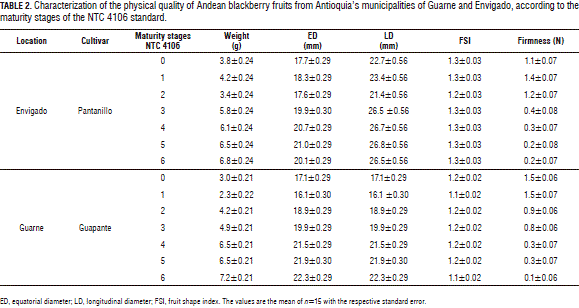
The fruits obtained from the crops of Envigado and Guarne reached a size of 20.1 and 22.3 mm, respectively, classified according to NTC 4106 as caliber C, which is a relatively small caliber for both locations. This result can be attributed to several factors including genotype, age and crop management, weather, and more. According to Grijalba et al. (2010), the base temperature for the blackberry is reported at 7°C, suggesting that, in cold weather, which occurs in the studied locations, there are sufficient heat units for development. Remberg et al. (2010), studying the influence of post-flowering temperatures on fruit size and chemical composition of the glen ample raspberry (Rubus idaeus L.) in Norway, observed that the berry weight decreased significantly with increasing temperatures (12, 18, and 24°C) and with progress of the harvest period.
The weight and diameter of the tested fruits increased with ripeness at a constant value (Tab. 2). Starting at maturity stage 4, no significant increases in fruit weight or diameter were observed, showing that it is not necessary to leave the fruits on the plant beyond this time, especially if you consider that maturity stages 5 and 6 are highly perishable. Besides, the NTC 4106 standard states that the degree of fruit development and stage should allow for transport and handling that facilitate a successful arrival at the destination. Contrary to the results observed for fruit weight and diameter, the FSI did not changed with ripening. This index represents the shape of the fruit: more conical as it moves away from 1 and more rounded as it approaches 1. In this sense, the results showed that the fruits of the crop in Envigado had a conical shape as compared to the fruits of the crop in Guarne. This suggests that fruit morphology is a characteristic related to genotype and bears no significant relation to fruit ripening. As therefore, it is only necessary to determine the equatorial diameter, considering that this is a commercial setting indicator of fruit size.
The physical characteristics of the drupes are distinctive of each blackberry genotype and have been classified into three groups: straight, concave and convex (Wada and Reed, 2010). Little variation of the shape of the drupes can occur in the same genotype (Tomlik-Wyremblewska et al., 2010).
Fruit firmness is a parameter highly related to blackberry shelf-life because these fruits are extremely delicate, which makes it a highly perishable fruit. As seen in Tab. 2, firmness values decreased with the progress of fruit ripening, from initial values of 1.1 to 1.5 N in stage 0 to values of 0.2 and 0.1 N in stage 6 in Envigado and Guarne, respectively. The observed values were similar to those reported by other authors for the blackberry and raspberry (Guedes et al., 2013; Maro et al., 2014).
In terms of finding models that quickly and easily connect different quality parameters with the fruit maturity stages of the blackberry, the fit of different linear relationship was evaluated. Figure 1 shows the results of fitting a linear model to describe the relationship between the weight and equatorial diameter of the fruits and maturity stages for each studied location. Both models showed a relatively strong relationship between the variables for the two locations, verifying a statistically significant relationship between the two parameters (weight and diameter) and fruit maturity stages with a confidence level of 95.0%. The statistical model allowed for a determination with a good fit (R2 > 70%) of differences of the fruit growth rate between Guarne (higher) and Envigado (lower), demonstrating its efficiency at making good comparisons and estimations based on weight and initial diameter when considering the genotype and the environment.
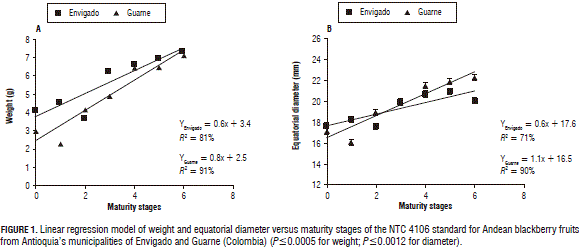
In this case, the linear model provided a fit as good as the other tested models, so the use of more complicated models is not justified. However, for firmness, the model with the best fit was exponential (R2 > 84%) (Fig. 2). Nevertheless, more data must be collected from more locations, genotypes and climates to generate systematic and accurate information that will refine the models.
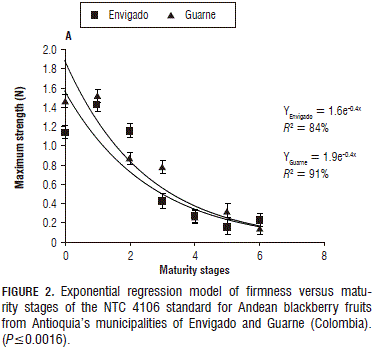
Table 3 shows the results of chemical parameters according to the maturity stages of NTC 4106. It can be seen that acidity decreased and total soluble solids (TSS) increased with the progress of fruit ripening, as would be expected. Guedes et al. (2013) reported values of 1.71% citric acid, 6.97°Brix and pH 2.95 for different blackberry cultivars harvested during the commercial maturity stage in a tropical climate at 918 m a.s.l. Ochmian et al. (2010) reported values of 2.34 g citric acid/100 g for blackberries (Rubus sp.) in Poland; nevertheless, Tosun et al. (2008), for ripe blackberries in Brazil, determined a doubled citric acid content (5.78 g citric acid/100 g). The results revealed strong influence from the growing site on fruit quality, as well as the existence of variation among the cultivars.
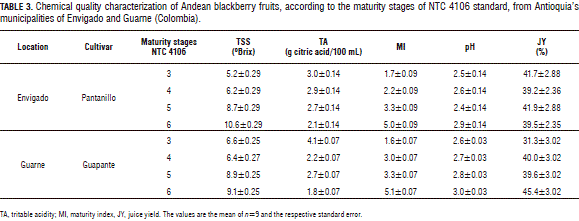
Furthermore, it should be noted that the juice yield was not related to the fruit maturity between stages 3 and 6 of the standard. As for weight, this parameter also suggested that it is not necessary to leave the fruit on the plant once maturity stage 4 is reached because the increase in this parameter was not significant and higher maturity stages imply a shorter shelf-life. However, this parameter is important for fresh consumption because of the juicy taste and for yield in the processing industry, so the percentage reached at stage 3 must be considered as the minimal percentage for quality.
As mentioned earlier, the SST increased with fruit maturity, but stage 4 showed values below 7 °Brix, the content demanded by the processing industry (Meals de Colombia, 2010). Vinasco et al. (2010) found that both of the blackberry cultivars (thorny and thornless) presented an SST lower than that required by the processing industry and, between the two cultivars, no significant differences were observed in any of the evaluated parameters: pH, size, weight and TSS.
The values found in this study were similar to those reported by other authors for ripe blackberry fruits. Grijalba et al. (2010) recorded an average of 5.60 °Brix for thornless blackberries and 5.69 °Brix for the genotype with thorns in maturity stage 4, values lower than those obtained by other authors, such as Vásquez et al. (2006) who recorded values between 7.7 and 9.1 °Brix for the Andean blackberry. Tosun et al. (2008) reported values of 7 to 11 °Brix for the green-ripe stage of blackberries in Brazil. Ochmian et al. (2010) reported 7.4 °Brix for blackberries (Rubus sp.) in Poland. Ali et al. (2011), explained that variations may occur in the chemical content in response to the location of the crop due to differences in solar radiation intensity and temperature ranges, which influence the organoleptic characteristics of fruits.
There was an exponential variation of TSS with fruit ripening for the Envigado crop, whereas, for the Guarne crop, it was linear (Fig. 3). Nevertheless, a linear increase in the maturity index (MI) according to the maturity stages of the NTC 4106 standard was observed for the two locations. Furthermore, the maturity index showed a significantly stronger correlation with the maturity stages and the equation of the model was similar for both locations, with a high fit (R2>93%). Thus suggesting that this parameter is a better indicator of maturity. However, this may depend on the market, as for fresh consumption is more important the balance between TSS and acidity, while for the industry are the SST content (°Brix).
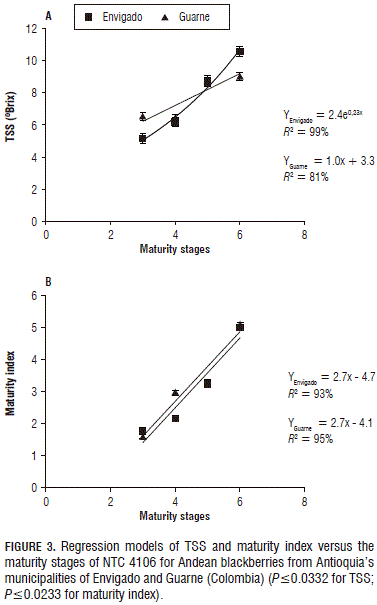
Color mathematical indices allow for quick and objective determinations of the fruit skin color, as well as the development of colored letters easier to handle in the field by farmers and packers (Riquelme-Ballesteros, 1995). As no mathematic color index was found in the literature for blackberries, indices of other fruits were applied, calculating the indices a* / b*, L* / b* (180-h°) / (L* + C*). All of the evaluated color indices showed the evolution of color according to the different stages of fruit maturity considered in NTC 4106 (Fig. 4). The equations a*/b* and (180-h°)/(L* + C*) were able to discriminate all of the color stages except 4 and 5, where only the index L*/b* was able to distinguish them, which in turn failed to separate stages 0 to 3.
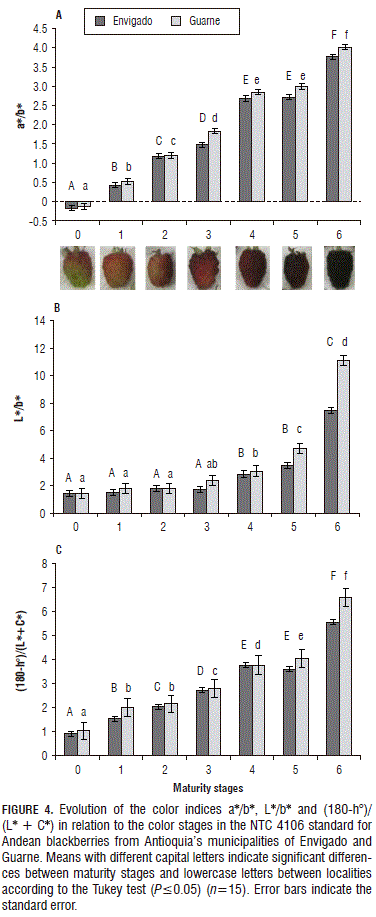
The color index a*/b* showed the best linear regression fit to the color scale of the standard (Fig. 5), with a very similar behavior for both locations. The quotient a*/b* is widely used to measure changes from greens to reds colors for fruits such as tomatoes and red plums. The index (180-h°)/(L* + C*) was proposed by Carreño et al. (1995) for the objective evaluation of purple colors in table grapes with a very good correlation with a visual color scale.
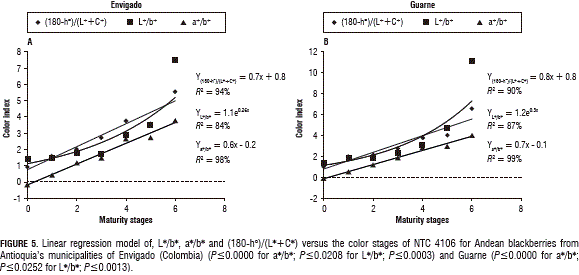
In Tab. 4, the average values found in Antioquia for the quality parameters studied in Andean blackberries are compared with respect to the ranges established by the NTC 4106 for each color stage. As can be seen, for Antioquia, the TSS recorded in states 4, 5 and 6 (6.3, 8.8 and 9.9, respectively) were higher than the ranges established by the standard (6.7 - 7.3, 7.2 - 7.9 and 7.7 - 8.5, respectively).
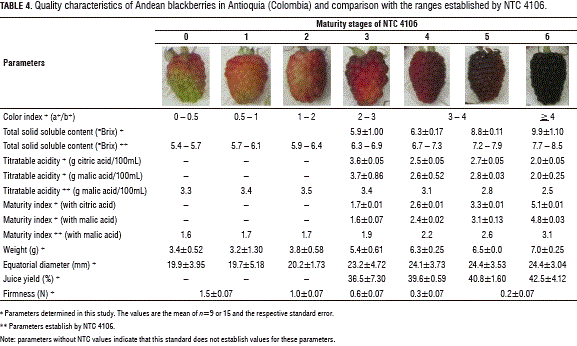
As the standard determined the titratable acidity in malic acid and our studied expressed the results in citric acid, we represented the two values of acid for comparison. Generally, the titratable acidity in blackberry is expressed as citric acid (Tosun et al., 2008; Ochmian et al., 2010; Guedes et al., 2013) but some authors expressed it in malic acid. Kafkas et al. (2006), studying the composition of some quality characteristics of five varieties of Rubus plicatus ('C. Thornless', 'Bursa 2', 'Navaho', 'Jumbo' and 'Loch Ness') in Turkey, found malic acid as the main organic acid, while citric acid was not detected in the blackberry fruits. More studies are necessary to better understand the possible effects of the species, genotype and environment. The results found for titratable acidity in Antioquia were similar to the standard.
The maturity index found in Antioquia for the Andean blackberry were higher, especially for maturity stages 5 and 6 (3.1 and 4.8, respectively) with respect to the standard (2.6 and 3.1, respectively).
Comparing the color scale of the NTC 4106 with the color index a*/b*, we can see that it was distinguished very well in each individual color stage with small values, except stages 4 and 5, as seen before. This brings the union of these stages into consideration because it can be very difficult to visually distinguish them. The development of visual color charts derived from data obtained with the colorimeter must be considered as it can help producers adapt to the reality the different tones of fruit color throughout ripening and, hence, provide a more homogeneous product and meet the quality requirements demanded by the market.
We must continue to collect data and include more locations, genotypes and environments to improve the model and increase the confidence level. It is necessary to consider the context of fruit development and environmental supply to properly define the criteria of the NTC 4106 standard in Colombia. Additionally, the relationship between the maturity index and sensorial attributes of Andean blackberries could be useful in better linking maturity changes with taste and defining cultivar and regional effects in terms of the maturity index and taste, thereby developing a future for the Protected Designation of Origin (PDO) that is oriented to markets of differentiated quality.
Conclusions
The statistical linear regression models used in this study showed good fits (R2 > 80%) and are a useful tool for quick and objective estimates of quality parameters in Andean blackberry fruits. It was found that the more suitable parameters to characterize the quality of Andean blackberry fruits are: weight, TSS, TA, MI, CI and firmness. Equatorial diameter maintained its relevance to the standard and market, along with juice yield. The ratio a*/b* is an objective index for determining the color of Andean blackberries. This index showed a good correlation (R2 > 98%) with the visual color of the fruit and was able to distinguish groups with different skin colors. Furthermore, it was found that the Colombian Technical Standard NTC 4106 for Andean blackberries should be reviewed and updated because, when applying this standard to the agroclimatic conditions of Antioquia, some of the established ranges were not reached. Instead of ranges strictly related to fruit color it should be defined minimal values for each quality parameter for each market (fresh market, national and export, and processing industry). More studies should be conducted with different genotypes and environmental factors (such as climate, soil, nutrition, agronomic practices and others) in order to create a dynamic model that will contribute to a better understanding and estimation of blackberry fruit development and quality and to meet market quality requirements.
Acknowledgments
The research for this paper was financially supported by the Ministry of Agriculture and Rural Development of Colombia, project No. 211-1781.
Literature cited
Acosta-Montoya, O., F. Vaillant, S. Cozzano, C. Mertz, A.M. Pérez, and M.V. Castro. 2010. Phenolic content and antioxidant capacity of tropical highland blackberry (Rubus adenotrichus Schltdl.) during three edible maturity stages. Food Chem. 119, 1497-1501. Doi: 10.1016/j.foodchem.2009.09.032 [ Links ]
Ali, L., B. Svensson, B.W. Alsanius, and M.E. Olsson. 2011. Late season harvest and storage of Rubus berries- Major antioxidant and sugar levels. Sci. Hortic. 129, 376-381. Doi: 10.1016/j.scienta.2011.03.047 [ Links ]
Bernal E., J.A. and C.A. Díaz D. 2006. Materiales locales y mejorados de tomate de árbol, mora y lulo sembrados por los agricultores y cultivares disponibles para su evaluación en Colombia. Corpoica, Rionegro, Colombia. [ Links ]
Carreño, J., A. Martínez, L. Almela, and J.A. Fernández. 1995. Proposal of an index for the objective evaluation of the colour of red table grapes. Food Res. Int. 28, 373-377. Doi: 10.1016/0963-9969(95)00008-A [ Links ]
Clark, J.R. and C.E. Finn. 2008. New trends in blackberry breeding. Acta Hort. 777, 41-47. [ Links ]
Clark J.R. and C.E. Finn. 2014. Blackberry cultivation in the world. Rev. Bras. Frutic. 36, 46-57. Doi: 10.1590/0100-2945-445/13 [ Links ]
Escobar, C. 2014. Cadena Productiva Nacional de la mora. Indicadores de apoyo. Cadenas Productivas, Ministerio de Agricultura y Desarrollo Rural, Bogota. [ Links ]
Espinosa B., N., D. Sánchez L., A. García R., M. Ariza N., C. Ariza N., and L.S. Barrero M. 2009. Evaluación agronómica, nutricional y selección participativa de materiales de mora en Silvania (Cundinamarca). pp. 34-42. In: Barrero M., L.S. (ed.). Caracterización, evaluación y producción de material limpio de mora con alto valor agregado. Corpoica; Ministerio de Agricultura y Desarrollo Rural, Mosquera, Colombia. [ Links ]
Grijalba R., C.M., L.A. Calderón M., and M.M. Pérez T. 2010. Rendimiento y calidad de la fruta en mora de Castilla (Rubus glaucus Benth), con y sin espinas, cultivada en campo abierto en Cajicá (Cundinamarca, Colombia). Rev. Fac. Cienc. Básicas 6, 24-41. [ Links ]
Guedes, M.N.S., C.M.P. de Abreu, L.A.C. Maro, R. PioII, J.R. de Abreu, and J.O. de Oliveira. 2013. Chemical characterization and mineral levels in the fruits of blackberry cultivars grown in a tropical climate at an elevation. Acta Sci., Agron. 35, 191-196. Doi: 10.4025/actasciagron.v35i2.16630 [ Links ]
Icontec. 1997. Frutas frescas. Mora de Castilla, especificaciones - NTC 4106. Norma Técnica Colombiana, Bogota. [ Links ]
Kafkas, E., M. Koşar, N. Türemiş, K.H.C. Başer. 2006. Analysis of sugars, organic acids and vitamin C contents of blackberry genotypes from Turkey. Food Chem. 97, 732-736. Doi: 10.1016/j.foodchem.2005.09.023 [ Links ]
Lewers, K.S., S.Y. Wang, and B.T. Vinyard. 2010. Evaluation of blackberry cultivars and breeding selections for fruit quality traits and flowering and fruiting dates. Crop Sci. 50, 2475-2491. Doi: 10.2135/cropsci2010.02.0097 [ Links ]
Maro, L.A.C., R. Pio, M.N.S. Guedes, C.M.P. de Abreu, and P.H.A. Moura. 2014. Environmental and genetic variation in the post-harvest quality of raspberries in subtropical areas in Brazil. Acta Sci., Agron. 36, 323-328. Doi: 10.4025/actasciagron.v36i3.18050 [ Links ]
Meals de Colombia. 2010. Ficha técnica de frutas mora con piton. Requisitos específicos. Armenia, Colombia. [ Links ]
Ochmian, I., J. Oszmianski, and K. Skupien. 2010. Chemical composition, phenolics, and firmness of small black fruits. J. Appl. Bot. Food Qual. 83, 64-69. [ Links ]
Radovich, A., M. Fotirich Aksich, V. Rakonjac, J. Milivojevich, D. Nikolich, and M. Nikolich. 2013. Diversity and relationship of yield components and fruit quality in promising floricane raspberry hybrids. Bulg. J. Agric. Sci. 19, 750-755. [ Links ]
Remberg, S.F., A. Sønsteby, K. Aaby, and O.M. Heide. 2010. Influence of postflowering temperature on fruit size and chemical composition of glen ample raspberry (Rubus idaeus L.). J. Agric. Food Chem. 58, 9120-9128. Doi: 10.1021/jf101736q [ Links ]
Riquelme-Ballesteros, F. 1995. Valoración del color en los frutos. pp. 593-595. In: Nuez, F. (ed.). El cultivo del tomate. Mundi-Prensa, Madrid. [ Links ]
Sebesta, B. 2014. Descriptive sensory analysis and composition of blackberry genotypes. Inquiry Univ. Ark. Undergrad. Res. J. 16, 21-46. [ Links ]
Tomlik-Wyremblewska, A., J. Zielinski, and M. Guzicka. 2010. Morphology and anatomy of blackberry pyrenes (Rubus L., Rosaceae) elementary studies of the European representatives of the genus Rubus L. Flora 205, 370-375. Doi: 10.1016/j.flora.2009.12.006 [ Links ]
Tosun, I., N.S. Unstun, and B. Tekguler. 2008. Physical and chemical changes during ripening of blackberrie fruits. Sci. Agric. 65, 87-90. Doi: 10.1590/S0103-90162008000100012 [ Links ]
Vásquez R., R.E., H.H. Ballesteros Ch., C.A. Muñoz O., and M.E. Cuellar Ch. 2006. Utilización de la abeja Apis mellifera como agente polinizador en cultivos comerciales de fresa (Fragaria chiloensis) y mora (Rubus glaucus) y su efecto en la producción. Corpoica, Bogota. [ Links ]
Vinasco, M., N. Mendez, L. Salazar, G. Ayala, C. Munar, Y. Munar, and C. Samboni. 2010. Evaluación de cinco parámetros de calidad en fruta de la mora de Castilla Rubus glaucus Benth variedad sin espinas comparada con la variedad con espinas, en cultivos de la zona sur del departamento del Huila. Rev. Investig. UNAD 9(suppl.), 235-244. [ Links ]
Wada, S. and B.M. Reed. 2010. Seed-coat morphology differentiates blackberry cultivars. J. Am. Pom. Soc. 64, 152-161. [ Links ]
Wójcik-Seliga, J. and E. Wójcik-Gront. 2013. Evaluation of blackberry and hybrid berry cultivars new to Polish climate - Short communication. Hort. Sci. (Prague) 40, 88-91. [ Links ]














